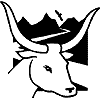HNV Showcases
Gräsö – land use mosaic
Even at the beginning of the 20th century, when the area used for farming reached its all time peak, only 8 % of the total area of Gräsö consisted of fields and meadows. The farms were very small with 5-7 dairy cows, a horse or two, a small flock of sheep, a few pigs and hens. The families survived on a combination of farming, fishing, charcoal making, shipping and other activities. This was life on Gräsö until the beginning of the 1960´s.
Since then the numbers of farms has fallen drastically, withthe numbers of dairy cows falling especially rapidly. The farmers are old, the herds are small, the farms small scale. Few young people want to take over a farm. This is causing the landscape to become overgrown.
Since then the numbers of farms has fallen drastically, withthe numbers of dairy cows falling especially rapidly. The farmers are old, the herds are small, the farms small scale. Few young people want to take over a farm. This is causing the landscape to become overgrown.
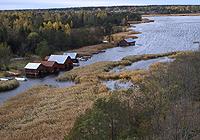 The coastal meadows were used both for grazing and for haymaking. These meadows were very important for the farmers since they produced far more fodder per hectare than the drier meadows inland. They are becoming overgrown with rushes as a result of abandonment.
The coastal meadows were used both for grazing and for haymaking. These meadows were very important for the farmers since they produced far more fodder per hectare than the drier meadows inland. They are becoming overgrown with rushes as a result of abandonment.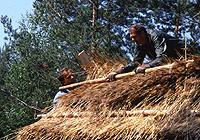 Rushes were, and still are today, commonly owned by each village. Rushes were the dominating roof laying material for outhouses.
Rushes were, and still are today, commonly owned by each village. Rushes were the dominating roof laying material for outhouses.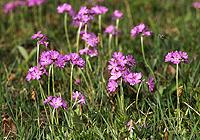 Bird’s eye primrose (Primula farinosa) is one of many species from the coastal meadows that needs grazing or mowing to survive. Other species in the lime rich moist meadow are purple moor grass (Molinia caerulea), blue moor grass (Sesleria caerulea), glaucous sedge (Carex flacca) and several orchids (Orchis spp.).
Bird’s eye primrose (Primula farinosa) is one of many species from the coastal meadows that needs grazing or mowing to survive. Other species in the lime rich moist meadow are purple moor grass (Molinia caerulea), blue moor grass (Sesleria caerulea), glaucous sedge (Carex flacca) and several orchids (Orchis spp.).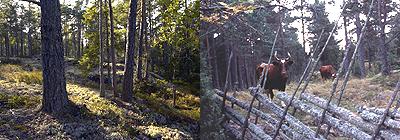
Until the 1920s forest grazing was the predominant form of pasture in Sweden. Only after a change in legislation forestry activities were considered the economical basis of forestland. The animals were removed from the woodlands, though some farmers didnít have enough grassland and continued to graze the forests.
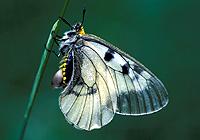 The Clouded Apollo – a species threatened by extinction
The Clouded Apollo – a species threatened by extinctionHazel grows commonly in the transition zones between forest and open land. During the spring Corydalis spp. flowers in sunny spots aroud the Hazel. The Clouded Apollo (Parnassius mnemosyne) larvae feeds of the Corydalis. The butterfly lives on many different herbaceous plants in both grazing fields and meadows. The butterfly flies from early to late June so late mowing or grazing of these grasslands is essential in order for the butterfly to survive. The scrubbing over of pastures, meadows and hazel habitats during the last decades has made the butterfly extremely rare. The Uppland Foundation and WWF Sweden have been running a project restoring several of its known localities for some years now. Scrub clearing, logging and the resumption of late grazing practices have proved very successful.
© Photos Gräsö: Sven-Olov Borgegård, Maria Hoflin, Ola Jennersten, Upplandsstiftelsen


